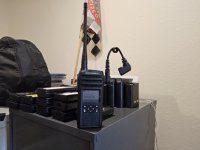+1 on using DTR series Motorola radios, if coverage will work. They get about a mile in the open and around a typical church/school campus reliably. I put several schools on DTR410 radios a decade ago and they are still working for them (on newer batteries which seem to last about 4-5 years before needing replacement).
DTR500/650 with longer antennas get better range, but I went with 410's as the fixed shorter antenna meant less likely to be damaged. My end user in the first school also did not want a scanner (or person with a "cheap Radio Shack" scanner), to be able to listen in to them. This school has about a dozen buildings in a city block, but part of that block was donated to the school, as long as it was left open to the public for baseball and basketball games. This means a campus where the public can often be seen flying kites, launching model rockets, and operating remote controlled cars. Decent size area but only a few brick buildings, and then portable classroom buildings in a city block size area, so great radio coverage, and frequency hopping (too fast for most scanners).
Cost of used and "new old stock" might make it practical. Having a reliable radio system that does not require a license (uses Industrial, Scientific, Medical [ISM] band), might be useful. This school had a recently expired UHF license and CP200 series UHF Motorola radios, but with a license it meant that they could have their frequencies listed as public knowledge. ISM band can be very secure if you do it right, in a reliable radio.
DTR500/650 with longer antennas get better range, but I went with 410's as the fixed shorter antenna meant less likely to be damaged. My end user in the first school also did not want a scanner (or person with a "cheap Radio Shack" scanner), to be able to listen in to them. This school has about a dozen buildings in a city block, but part of that block was donated to the school, as long as it was left open to the public for baseball and basketball games. This means a campus where the public can often be seen flying kites, launching model rockets, and operating remote controlled cars. Decent size area but only a few brick buildings, and then portable classroom buildings in a city block size area, so great radio coverage, and frequency hopping (too fast for most scanners).
Cost of used and "new old stock" might make it practical. Having a reliable radio system that does not require a license (uses Industrial, Scientific, Medical [ISM] band), might be useful. This school had a recently expired UHF license and CP200 series UHF Motorola radios, but with a license it meant that they could have their frequencies listed as public knowledge. ISM band can be very secure if you do it right, in a reliable radio.


